Wireless Network Security and Preventive Techniques Research Report
VerifiedAdded on 2022/12/12
|10
|2595
|348
Report
AI Summary
This report delves into the critical aspects of wireless network security and the preventive techniques necessary to safeguard networks in both home and corporate environments. It begins by outlining the challenges inherent in wireless networks, including denial-of-service attacks, rogue access points, configuration errors, and passive capturing, emphasizing how these vulnerabilities extend beyond the physical boundaries of an organization. The paper then proposes solutions, highlighting Cisco's Self-Defending Network (SDN) as a strategy to automatically detect and prevent security threats. It details best practices such as establishing comprehensive WLAN policies, securing communications through authentication and encryption, modifying default SSIDs, employing strong encryption methods, utilizing alternative security measures for specific clients, segmenting users with identity networks, and ensuring the security of management ports. The report underscores the importance of continuous employee education and training to maintain network integrity, concluding that implementing these preventive measures significantly reduces risks associated with wireless attacks.
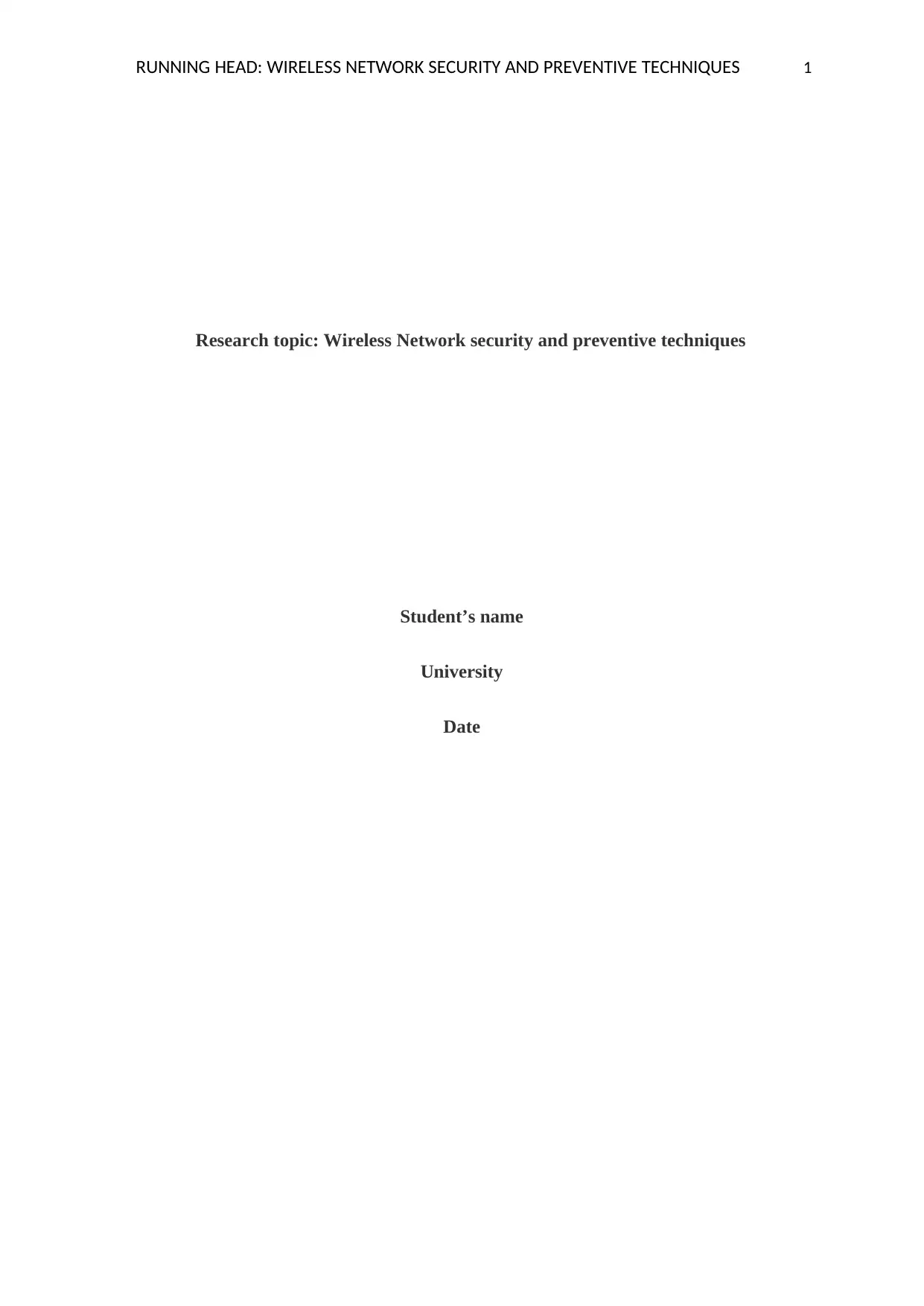
RUNNING HEAD: WIRELESS NETWORK SECURITY AND PREVENTIVE TECHNIQUES 1
Research topic: Wireless Network security and preventive techniques
Student’s name
University
Date
Research topic: Wireless Network security and preventive techniques
Student’s name
University
Date
Paraphrase This Document
Need a fresh take? Get an instant paraphrase of this document with our AI Paraphraser
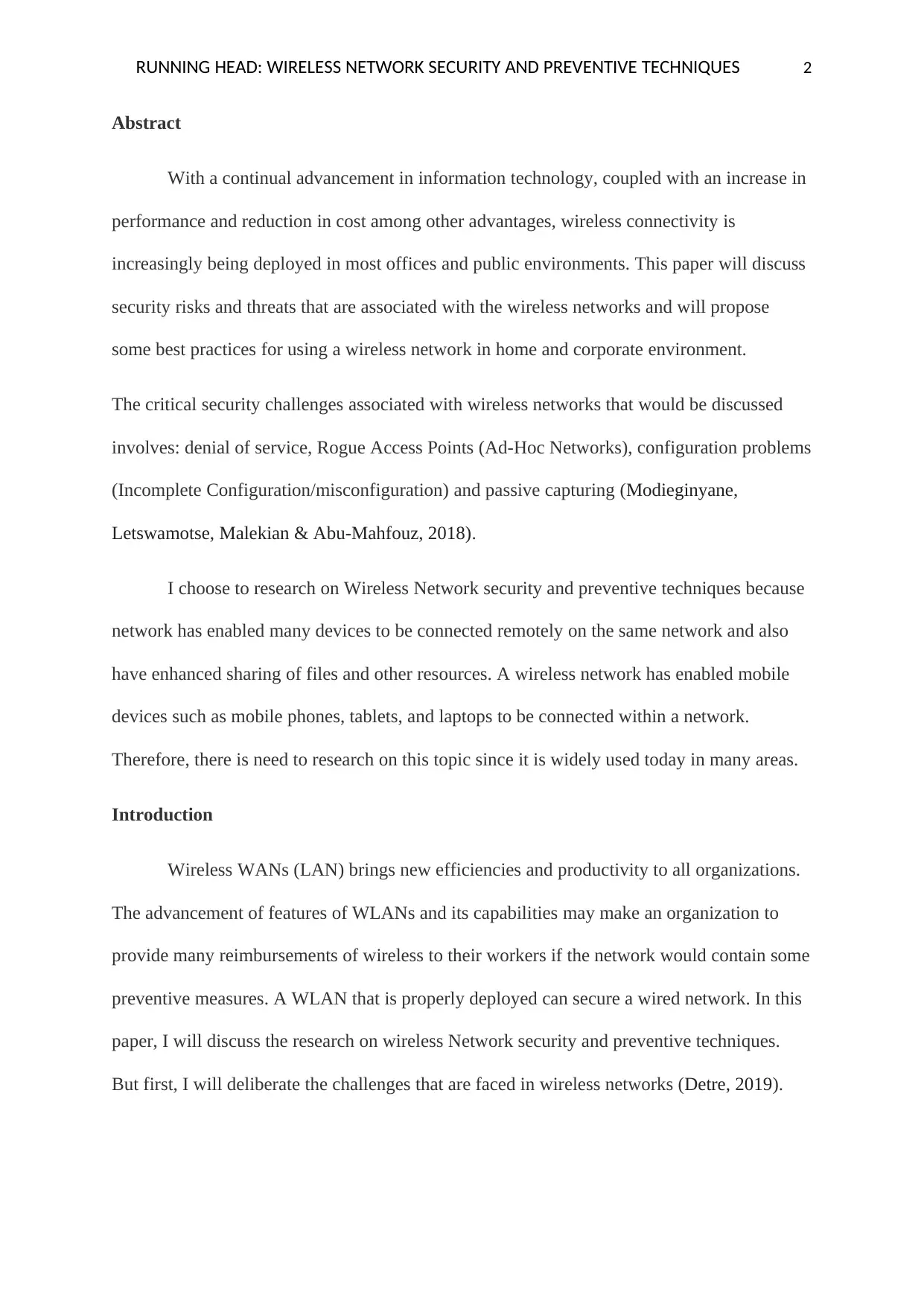
RUNNING HEAD: WIRELESS NETWORK SECURITY AND PREVENTIVE TECHNIQUES 2
Abstract
With a continual advancement in information technology, coupled with an increase in
performance and reduction in cost among other advantages, wireless connectivity is
increasingly being deployed in most offices and public environments. This paper will discuss
security risks and threats that are associated with the wireless networks and will propose
some best practices for using a wireless network in home and corporate environment.
The critical security challenges associated with wireless networks that would be discussed
involves: denial of service, Rogue Access Points (Ad-Hoc Networks), configuration problems
(Incomplete Configuration/misconfiguration) and passive capturing (Modieginyane,
Letswamotse, Malekian & Abu-Mahfouz, 2018).
I choose to research on Wireless Network security and preventive techniques because
network has enabled many devices to be connected remotely on the same network and also
have enhanced sharing of files and other resources. A wireless network has enabled mobile
devices such as mobile phones, tablets, and laptops to be connected within a network.
Therefore, there is need to research on this topic since it is widely used today in many areas.
Introduction
Wireless WANs (LAN) brings new efficiencies and productivity to all organizations.
The advancement of features of WLANs and its capabilities may make an organization to
provide many reimbursements of wireless to their workers if the network would contain some
preventive measures. A WLAN that is properly deployed can secure a wired network. In this
paper, I will discuss the research on wireless Network security and preventive techniques.
But first, I will deliberate the challenges that are faced in wireless networks (Detre, 2019).
Abstract
With a continual advancement in information technology, coupled with an increase in
performance and reduction in cost among other advantages, wireless connectivity is
increasingly being deployed in most offices and public environments. This paper will discuss
security risks and threats that are associated with the wireless networks and will propose
some best practices for using a wireless network in home and corporate environment.
The critical security challenges associated with wireless networks that would be discussed
involves: denial of service, Rogue Access Points (Ad-Hoc Networks), configuration problems
(Incomplete Configuration/misconfiguration) and passive capturing (Modieginyane,
Letswamotse, Malekian & Abu-Mahfouz, 2018).
I choose to research on Wireless Network security and preventive techniques because
network has enabled many devices to be connected remotely on the same network and also
have enhanced sharing of files and other resources. A wireless network has enabled mobile
devices such as mobile phones, tablets, and laptops to be connected within a network.
Therefore, there is need to research on this topic since it is widely used today in many areas.
Introduction
Wireless WANs (LAN) brings new efficiencies and productivity to all organizations.
The advancement of features of WLANs and its capabilities may make an organization to
provide many reimbursements of wireless to their workers if the network would contain some
preventive measures. A WLAN that is properly deployed can secure a wired network. In this
paper, I will discuss the research on wireless Network security and preventive techniques.
But first, I will deliberate the challenges that are faced in wireless networks (Detre, 2019).
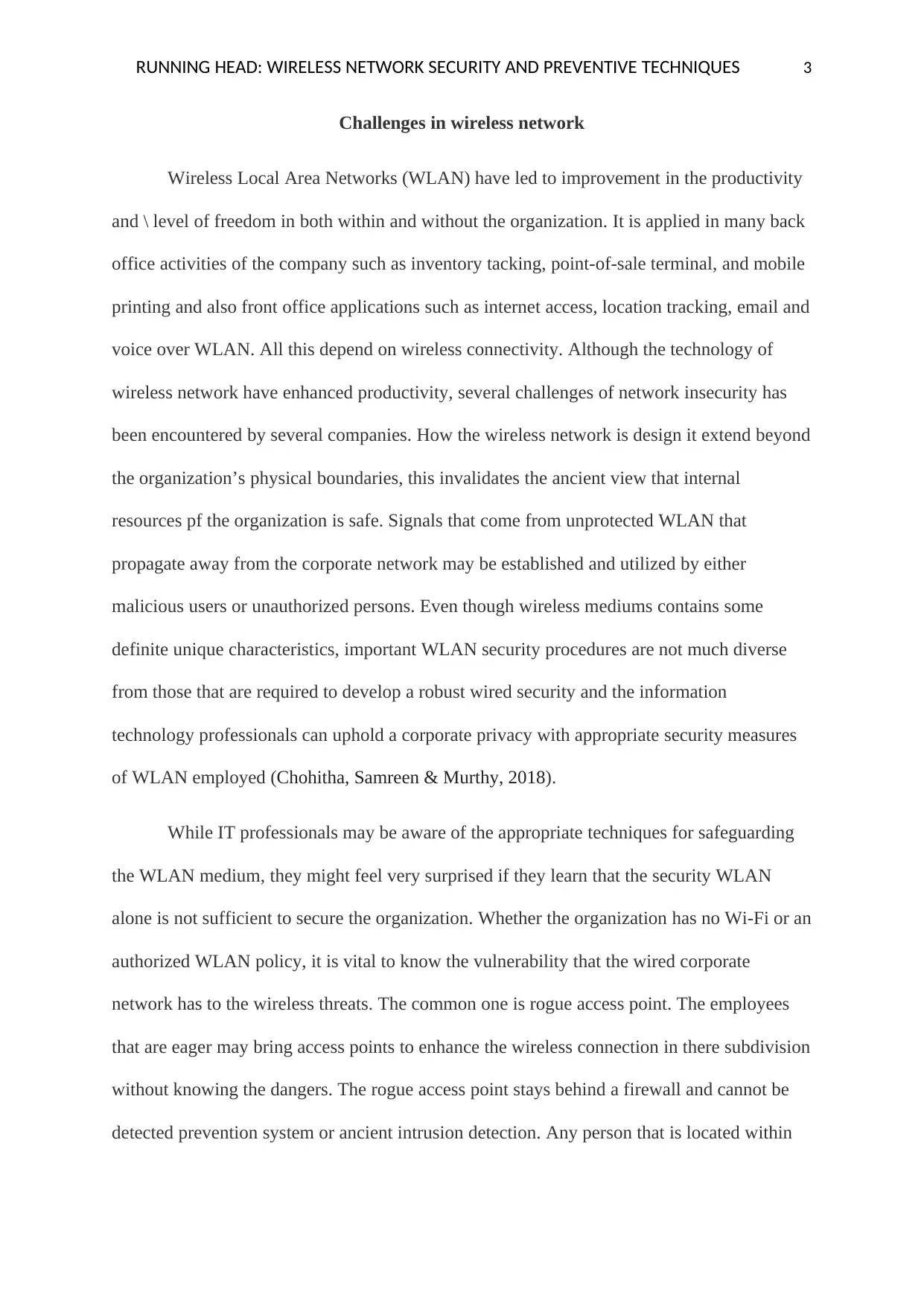
RUNNING HEAD: WIRELESS NETWORK SECURITY AND PREVENTIVE TECHNIQUES 3
Challenges in wireless network
Wireless Local Area Networks (WLAN) have led to improvement in the productivity
and \ level of freedom in both within and without the organization. It is applied in many back
office activities of the company such as inventory tacking, point-of-sale terminal, and mobile
printing and also front office applications such as internet access, location tracking, email and
voice over WLAN. All this depend on wireless connectivity. Although the technology of
wireless network have enhanced productivity, several challenges of network insecurity has
been encountered by several companies. How the wireless network is design it extend beyond
the organization’s physical boundaries, this invalidates the ancient view that internal
resources pf the organization is safe. Signals that come from unprotected WLAN that
propagate away from the corporate network may be established and utilized by either
malicious users or unauthorized persons. Even though wireless mediums contains some
definite unique characteristics, important WLAN security procedures are not much diverse
from those that are required to develop a robust wired security and the information
technology professionals can uphold a corporate privacy with appropriate security measures
of WLAN employed (Chohitha, Samreen & Murthy, 2018).
While IT professionals may be aware of the appropriate techniques for safeguarding
the WLAN medium, they might feel very surprised if they learn that the security WLAN
alone is not sufficient to secure the organization. Whether the organization has no Wi-Fi or an
authorized WLAN policy, it is vital to know the vulnerability that the wired corporate
network has to the wireless threats. The common one is rogue access point. The employees
that are eager may bring access points to enhance the wireless connection in there subdivision
without knowing the dangers. The rogue access point stays behind a firewall and cannot be
detected prevention system or ancient intrusion detection. Any person that is located within
Challenges in wireless network
Wireless Local Area Networks (WLAN) have led to improvement in the productivity
and \ level of freedom in both within and without the organization. It is applied in many back
office activities of the company such as inventory tacking, point-of-sale terminal, and mobile
printing and also front office applications such as internet access, location tracking, email and
voice over WLAN. All this depend on wireless connectivity. Although the technology of
wireless network have enhanced productivity, several challenges of network insecurity has
been encountered by several companies. How the wireless network is design it extend beyond
the organization’s physical boundaries, this invalidates the ancient view that internal
resources pf the organization is safe. Signals that come from unprotected WLAN that
propagate away from the corporate network may be established and utilized by either
malicious users or unauthorized persons. Even though wireless mediums contains some
definite unique characteristics, important WLAN security procedures are not much diverse
from those that are required to develop a robust wired security and the information
technology professionals can uphold a corporate privacy with appropriate security measures
of WLAN employed (Chohitha, Samreen & Murthy, 2018).
While IT professionals may be aware of the appropriate techniques for safeguarding
the WLAN medium, they might feel very surprised if they learn that the security WLAN
alone is not sufficient to secure the organization. Whether the organization has no Wi-Fi or an
authorized WLAN policy, it is vital to know the vulnerability that the wired corporate
network has to the wireless threats. The common one is rogue access point. The employees
that are eager may bring access points to enhance the wireless connection in there subdivision
without knowing the dangers. The rogue access point stays behind a firewall and cannot be
detected prevention system or ancient intrusion detection. Any person that is located within
⊘ This is a preview!⊘
Do you want full access?
Subscribe today to unlock all pages.

Trusted by 1+ million students worldwide
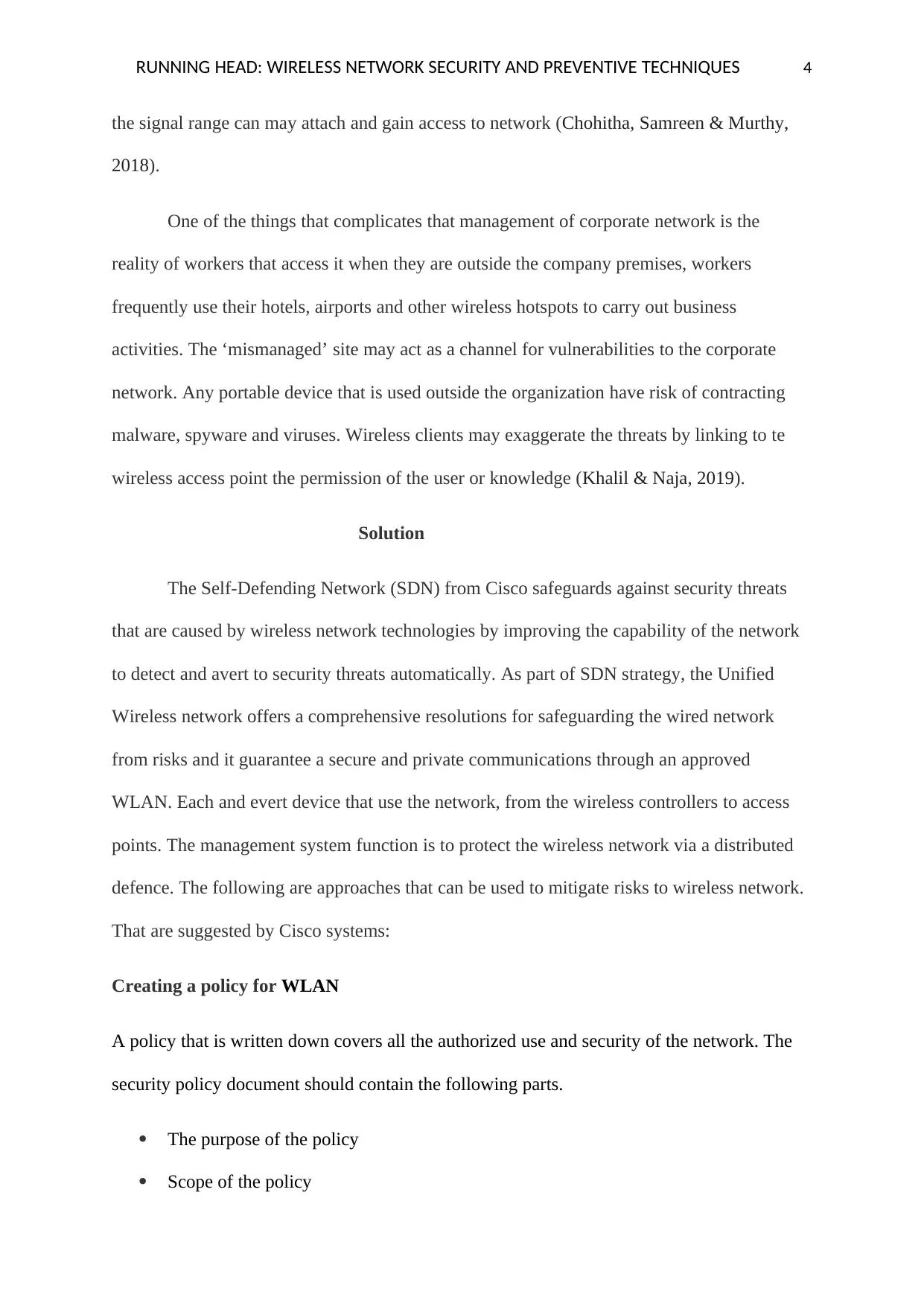
RUNNING HEAD: WIRELESS NETWORK SECURITY AND PREVENTIVE TECHNIQUES 4
the signal range can may attach and gain access to network (Chohitha, Samreen & Murthy,
2018).
One of the things that complicates that management of corporate network is the
reality of workers that access it when they are outside the company premises, workers
frequently use their hotels, airports and other wireless hotspots to carry out business
activities. The ‘mismanaged’ site may act as a channel for vulnerabilities to the corporate
network. Any portable device that is used outside the organization have risk of contracting
malware, spyware and viruses. Wireless clients may exaggerate the threats by linking to te
wireless access point the permission of the user or knowledge (Khalil & Naja, 2019).
Solution
The Self-Defending Network (SDN) from Cisco safeguards against security threats
that are caused by wireless network technologies by improving the capability of the network
to detect and avert to security threats automatically. As part of SDN strategy, the Unified
Wireless network offers a comprehensive resolutions for safeguarding the wired network
from risks and it guarantee a secure and private communications through an approved
WLAN. Each and evert device that use the network, from the wireless controllers to access
points. The management system function is to protect the wireless network via a distributed
defence. The following are approaches that can be used to mitigate risks to wireless network.
That are suggested by Cisco systems:
Creating a policy for WLAN
A policy that is written down covers all the authorized use and security of the network. The
security policy document should contain the following parts.
The purpose of the policy
Scope of the policy
the signal range can may attach and gain access to network (Chohitha, Samreen & Murthy,
2018).
One of the things that complicates that management of corporate network is the
reality of workers that access it when they are outside the company premises, workers
frequently use their hotels, airports and other wireless hotspots to carry out business
activities. The ‘mismanaged’ site may act as a channel for vulnerabilities to the corporate
network. Any portable device that is used outside the organization have risk of contracting
malware, spyware and viruses. Wireless clients may exaggerate the threats by linking to te
wireless access point the permission of the user or knowledge (Khalil & Naja, 2019).
Solution
The Self-Defending Network (SDN) from Cisco safeguards against security threats
that are caused by wireless network technologies by improving the capability of the network
to detect and avert to security threats automatically. As part of SDN strategy, the Unified
Wireless network offers a comprehensive resolutions for safeguarding the wired network
from risks and it guarantee a secure and private communications through an approved
WLAN. Each and evert device that use the network, from the wireless controllers to access
points. The management system function is to protect the wireless network via a distributed
defence. The following are approaches that can be used to mitigate risks to wireless network.
That are suggested by Cisco systems:
Creating a policy for WLAN
A policy that is written down covers all the authorized use and security of the network. The
security policy document should contain the following parts.
The purpose of the policy
Scope of the policy
Paraphrase This Document
Need a fresh take? Get an instant paraphrase of this document with our AI Paraphraser
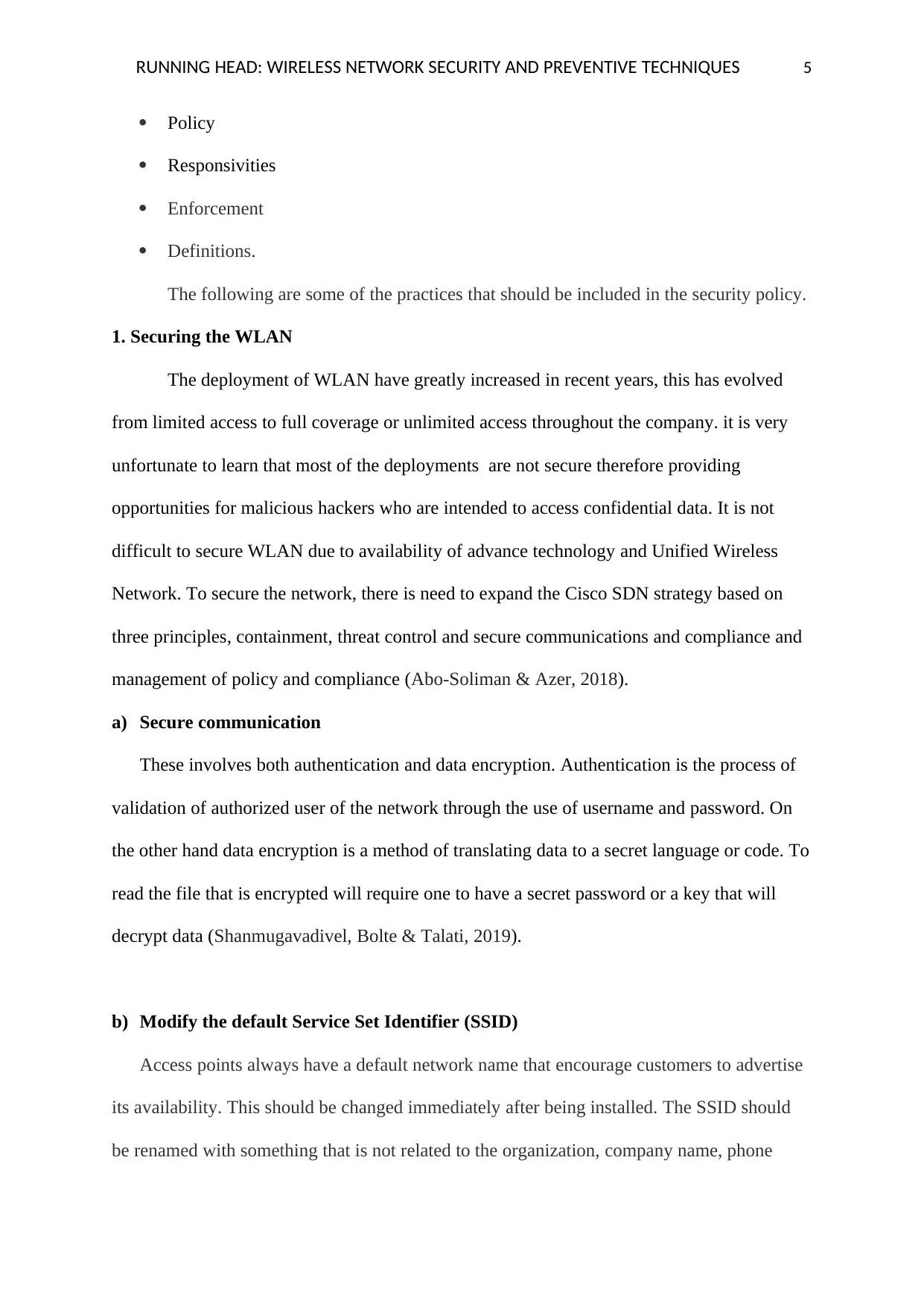
RUNNING HEAD: WIRELESS NETWORK SECURITY AND PREVENTIVE TECHNIQUES 5
Policy
Responsivities
Enforcement
Definitions.
The following are some of the practices that should be included in the security policy.
1. Securing the WLAN
The deployment of WLAN have greatly increased in recent years, this has evolved
from limited access to full coverage or unlimited access throughout the company. it is very
unfortunate to learn that most of the deployments are not secure therefore providing
opportunities for malicious hackers who are intended to access confidential data. It is not
difficult to secure WLAN due to availability of advance technology and Unified Wireless
Network. To secure the network, there is need to expand the Cisco SDN strategy based on
three principles, containment, threat control and secure communications and compliance and
management of policy and compliance (Abo-Soliman & Azer, 2018).
a) Secure communication
These involves both authentication and data encryption. Authentication is the process of
validation of authorized user of the network through the use of username and password. On
the other hand data encryption is a method of translating data to a secret language or code. To
read the file that is encrypted will require one to have a secret password or a key that will
decrypt data (Shanmugavadivel, Bolte & Talati, 2019).
b) Modify the default Service Set Identifier (SSID)
Access points always have a default network name that encourage customers to advertise
its availability. This should be changed immediately after being installed. The SSID should
be renamed with something that is not related to the organization, company name, phone
Policy
Responsivities
Enforcement
Definitions.
The following are some of the practices that should be included in the security policy.
1. Securing the WLAN
The deployment of WLAN have greatly increased in recent years, this has evolved
from limited access to full coverage or unlimited access throughout the company. it is very
unfortunate to learn that most of the deployments are not secure therefore providing
opportunities for malicious hackers who are intended to access confidential data. It is not
difficult to secure WLAN due to availability of advance technology and Unified Wireless
Network. To secure the network, there is need to expand the Cisco SDN strategy based on
three principles, containment, threat control and secure communications and compliance and
management of policy and compliance (Abo-Soliman & Azer, 2018).
a) Secure communication
These involves both authentication and data encryption. Authentication is the process of
validation of authorized user of the network through the use of username and password. On
the other hand data encryption is a method of translating data to a secret language or code. To
read the file that is encrypted will require one to have a secret password or a key that will
decrypt data (Shanmugavadivel, Bolte & Talati, 2019).
b) Modify the default Service Set Identifier (SSID)
Access points always have a default network name that encourage customers to advertise
its availability. This should be changed immediately after being installed. The SSID should
be renamed with something that is not related to the organization, company name, phone
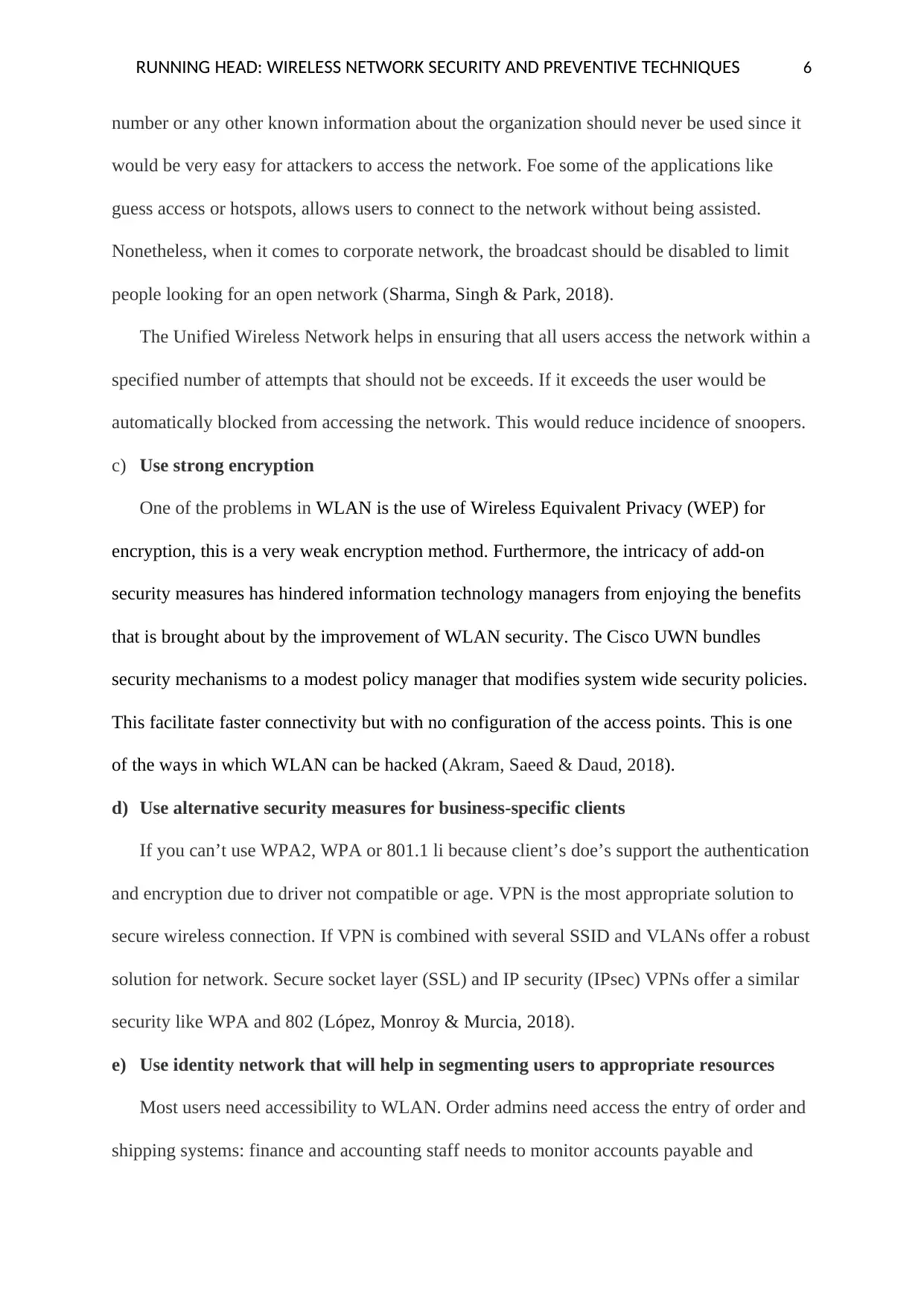
RUNNING HEAD: WIRELESS NETWORK SECURITY AND PREVENTIVE TECHNIQUES 6
number or any other known information about the organization should never be used since it
would be very easy for attackers to access the network. Foe some of the applications like
guess access or hotspots, allows users to connect to the network without being assisted.
Nonetheless, when it comes to corporate network, the broadcast should be disabled to limit
people looking for an open network (Sharma, Singh & Park, 2018).
The Unified Wireless Network helps in ensuring that all users access the network within a
specified number of attempts that should not be exceeds. If it exceeds the user would be
automatically blocked from accessing the network. This would reduce incidence of snoopers.
c) Use strong encryption
One of the problems in WLAN is the use of Wireless Equivalent Privacy (WEP) for
encryption, this is a very weak encryption method. Furthermore, the intricacy of add-on
security measures has hindered information technology managers from enjoying the benefits
that is brought about by the improvement of WLAN security. The Cisco UWN bundles
security mechanisms to a modest policy manager that modifies system wide security policies.
This facilitate faster connectivity but with no configuration of the access points. This is one
of the ways in which WLAN can be hacked (Akram, Saeed & Daud, 2018).
d) Use alternative security measures for business-specific clients
If you can’t use WPA2, WPA or 801.1 li because client’s doe’s support the authentication
and encryption due to driver not compatible or age. VPN is the most appropriate solution to
secure wireless connection. If VPN is combined with several SSID and VLANs offer a robust
solution for network. Secure socket layer (SSL) and IP security (IPsec) VPNs offer a similar
security like WPA and 802 (López, Monroy & Murcia, 2018).
e) Use identity network that will help in segmenting users to appropriate resources
Most users need accessibility to WLAN. Order admins need access the entry of order and
shipping systems: finance and accounting staff needs to monitor accounts payable and
number or any other known information about the organization should never be used since it
would be very easy for attackers to access the network. Foe some of the applications like
guess access or hotspots, allows users to connect to the network without being assisted.
Nonetheless, when it comes to corporate network, the broadcast should be disabled to limit
people looking for an open network (Sharma, Singh & Park, 2018).
The Unified Wireless Network helps in ensuring that all users access the network within a
specified number of attempts that should not be exceeds. If it exceeds the user would be
automatically blocked from accessing the network. This would reduce incidence of snoopers.
c) Use strong encryption
One of the problems in WLAN is the use of Wireless Equivalent Privacy (WEP) for
encryption, this is a very weak encryption method. Furthermore, the intricacy of add-on
security measures has hindered information technology managers from enjoying the benefits
that is brought about by the improvement of WLAN security. The Cisco UWN bundles
security mechanisms to a modest policy manager that modifies system wide security policies.
This facilitate faster connectivity but with no configuration of the access points. This is one
of the ways in which WLAN can be hacked (Akram, Saeed & Daud, 2018).
d) Use alternative security measures for business-specific clients
If you can’t use WPA2, WPA or 801.1 li because client’s doe’s support the authentication
and encryption due to driver not compatible or age. VPN is the most appropriate solution to
secure wireless connection. If VPN is combined with several SSID and VLANs offer a robust
solution for network. Secure socket layer (SSL) and IP security (IPsec) VPNs offer a similar
security like WPA and 802 (López, Monroy & Murcia, 2018).
e) Use identity network that will help in segmenting users to appropriate resources
Most users need accessibility to WLAN. Order admins need access the entry of order and
shipping systems: finance and accounting staff needs to monitor accounts payable and
⊘ This is a preview!⊘
Do you want full access?
Subscribe today to unlock all pages.

Trusted by 1+ million students worldwide
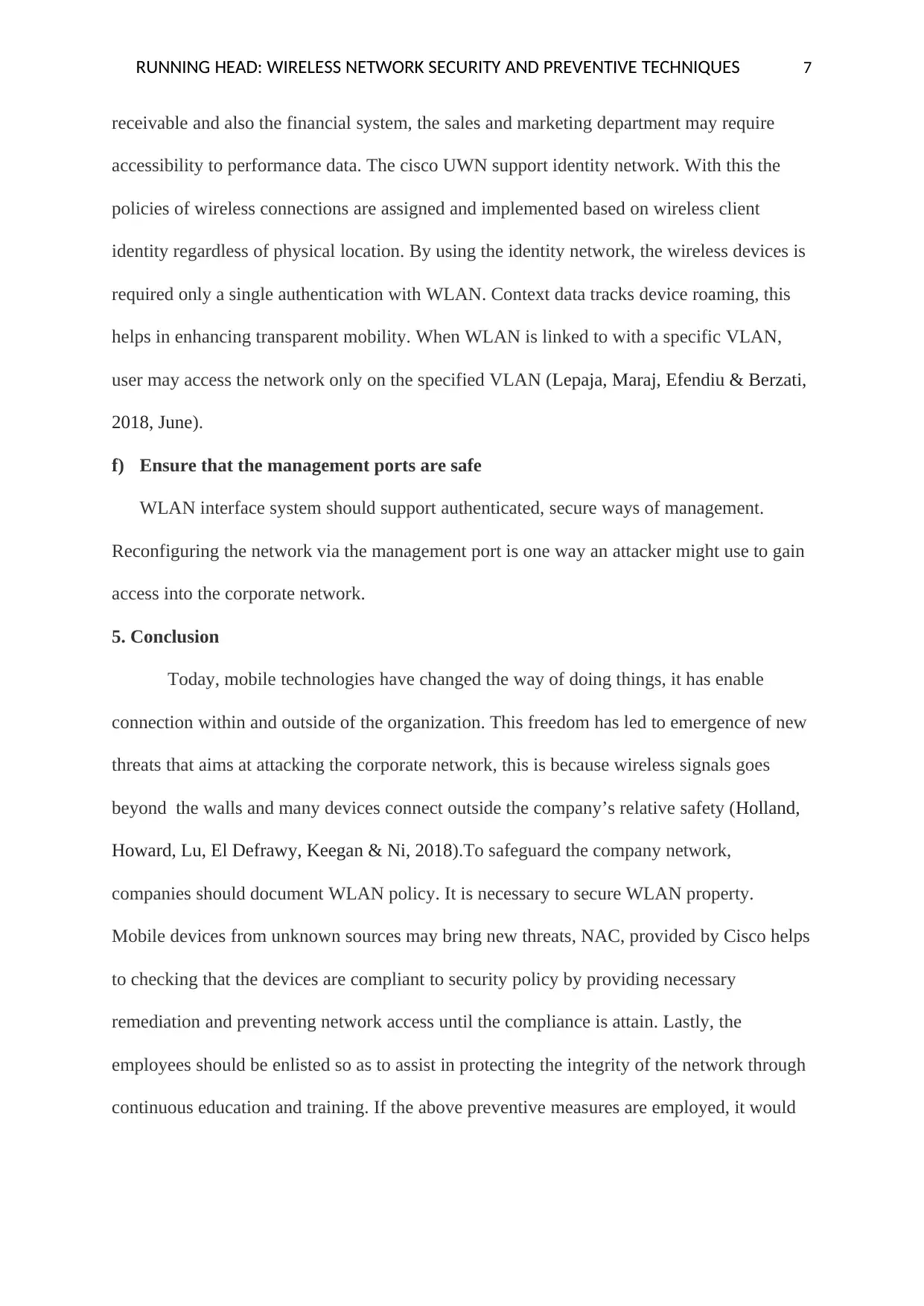
RUNNING HEAD: WIRELESS NETWORK SECURITY AND PREVENTIVE TECHNIQUES 7
receivable and also the financial system, the sales and marketing department may require
accessibility to performance data. The cisco UWN support identity network. With this the
policies of wireless connections are assigned and implemented based on wireless client
identity regardless of physical location. By using the identity network, the wireless devices is
required only a single authentication with WLAN. Context data tracks device roaming, this
helps in enhancing transparent mobility. When WLAN is linked to with a specific VLAN,
user may access the network only on the specified VLAN (Lepaja, Maraj, Efendiu & Berzati,
2018, June).
f) Ensure that the management ports are safe
WLAN interface system should support authenticated, secure ways of management.
Reconfiguring the network via the management port is one way an attacker might use to gain
access into the corporate network.
5. Conclusion
Today, mobile technologies have changed the way of doing things, it has enable
connection within and outside of the organization. This freedom has led to emergence of new
threats that aims at attacking the corporate network, this is because wireless signals goes
beyond the walls and many devices connect outside the company’s relative safety (Holland,
Howard, Lu, El Defrawy, Keegan & Ni, 2018).To safeguard the company network,
companies should document WLAN policy. It is necessary to secure WLAN property.
Mobile devices from unknown sources may bring new threats, NAC, provided by Cisco helps
to checking that the devices are compliant to security policy by providing necessary
remediation and preventing network access until the compliance is attain. Lastly, the
employees should be enlisted so as to assist in protecting the integrity of the network through
continuous education and training. If the above preventive measures are employed, it would
receivable and also the financial system, the sales and marketing department may require
accessibility to performance data. The cisco UWN support identity network. With this the
policies of wireless connections are assigned and implemented based on wireless client
identity regardless of physical location. By using the identity network, the wireless devices is
required only a single authentication with WLAN. Context data tracks device roaming, this
helps in enhancing transparent mobility. When WLAN is linked to with a specific VLAN,
user may access the network only on the specified VLAN (Lepaja, Maraj, Efendiu & Berzati,
2018, June).
f) Ensure that the management ports are safe
WLAN interface system should support authenticated, secure ways of management.
Reconfiguring the network via the management port is one way an attacker might use to gain
access into the corporate network.
5. Conclusion
Today, mobile technologies have changed the way of doing things, it has enable
connection within and outside of the organization. This freedom has led to emergence of new
threats that aims at attacking the corporate network, this is because wireless signals goes
beyond the walls and many devices connect outside the company’s relative safety (Holland,
Howard, Lu, El Defrawy, Keegan & Ni, 2018).To safeguard the company network,
companies should document WLAN policy. It is necessary to secure WLAN property.
Mobile devices from unknown sources may bring new threats, NAC, provided by Cisco helps
to checking that the devices are compliant to security policy by providing necessary
remediation and preventing network access until the compliance is attain. Lastly, the
employees should be enlisted so as to assist in protecting the integrity of the network through
continuous education and training. If the above preventive measures are employed, it would
Paraphrase This Document
Need a fresh take? Get an instant paraphrase of this document with our AI Paraphraser

RUNNING HEAD: WIRELESS NETWORK SECURITY AND PREVENTIVE TECHNIQUES 8
significantly reduce risk to WLAN and from wireless attacks (Modieginyane, Letswamotse,
Malekian & Abu-Mahfouz, 2018)
significantly reduce risk to WLAN and from wireless attacks (Modieginyane, Letswamotse,
Malekian & Abu-Mahfouz, 2018)
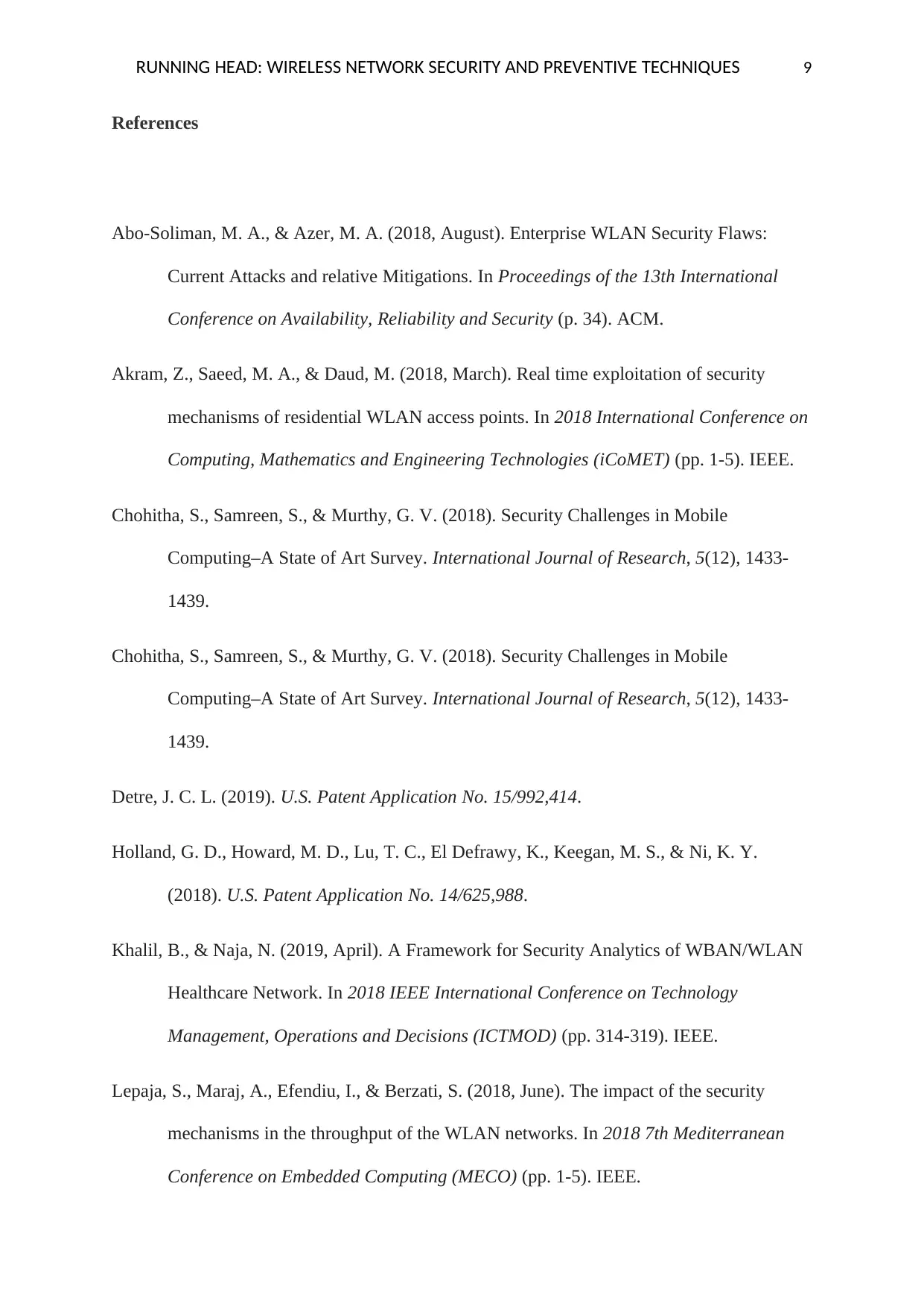
RUNNING HEAD: WIRELESS NETWORK SECURITY AND PREVENTIVE TECHNIQUES 9
References
Abo-Soliman, M. A., & Azer, M. A. (2018, August). Enterprise WLAN Security Flaws:
Current Attacks and relative Mitigations. In Proceedings of the 13th International
Conference on Availability, Reliability and Security (p. 34). ACM.
Akram, Z., Saeed, M. A., & Daud, M. (2018, March). Real time exploitation of security
mechanisms of residential WLAN access points. In 2018 International Conference on
Computing, Mathematics and Engineering Technologies (iCoMET) (pp. 1-5). IEEE.
Chohitha, S., Samreen, S., & Murthy, G. V. (2018). Security Challenges in Mobile
Computing–A State of Art Survey. International Journal of Research, 5(12), 1433-
1439.
Chohitha, S., Samreen, S., & Murthy, G. V. (2018). Security Challenges in Mobile
Computing–A State of Art Survey. International Journal of Research, 5(12), 1433-
1439.
Detre, J. C. L. (2019). U.S. Patent Application No. 15/992,414.
Holland, G. D., Howard, M. D., Lu, T. C., El Defrawy, K., Keegan, M. S., & Ni, K. Y.
(2018). U.S. Patent Application No. 14/625,988.
Khalil, B., & Naja, N. (2019, April). A Framework for Security Analytics of WBAN/WLAN
Healthcare Network. In 2018 IEEE International Conference on Technology
Management, Operations and Decisions (ICTMOD) (pp. 314-319). IEEE.
Lepaja, S., Maraj, A., Efendiu, I., & Berzati, S. (2018, June). The impact of the security
mechanisms in the throughput of the WLAN networks. In 2018 7th Mediterranean
Conference on Embedded Computing (MECO) (pp. 1-5). IEEE.
References
Abo-Soliman, M. A., & Azer, M. A. (2018, August). Enterprise WLAN Security Flaws:
Current Attacks and relative Mitigations. In Proceedings of the 13th International
Conference on Availability, Reliability and Security (p. 34). ACM.
Akram, Z., Saeed, M. A., & Daud, M. (2018, March). Real time exploitation of security
mechanisms of residential WLAN access points. In 2018 International Conference on
Computing, Mathematics and Engineering Technologies (iCoMET) (pp. 1-5). IEEE.
Chohitha, S., Samreen, S., & Murthy, G. V. (2018). Security Challenges in Mobile
Computing–A State of Art Survey. International Journal of Research, 5(12), 1433-
1439.
Chohitha, S., Samreen, S., & Murthy, G. V. (2018). Security Challenges in Mobile
Computing–A State of Art Survey. International Journal of Research, 5(12), 1433-
1439.
Detre, J. C. L. (2019). U.S. Patent Application No. 15/992,414.
Holland, G. D., Howard, M. D., Lu, T. C., El Defrawy, K., Keegan, M. S., & Ni, K. Y.
(2018). U.S. Patent Application No. 14/625,988.
Khalil, B., & Naja, N. (2019, April). A Framework for Security Analytics of WBAN/WLAN
Healthcare Network. In 2018 IEEE International Conference on Technology
Management, Operations and Decisions (ICTMOD) (pp. 314-319). IEEE.
Lepaja, S., Maraj, A., Efendiu, I., & Berzati, S. (2018, June). The impact of the security
mechanisms in the throughput of the WLAN networks. In 2018 7th Mediterranean
Conference on Embedded Computing (MECO) (pp. 1-5). IEEE.
⊘ This is a preview!⊘
Do you want full access?
Subscribe today to unlock all pages.

Trusted by 1+ million students worldwide
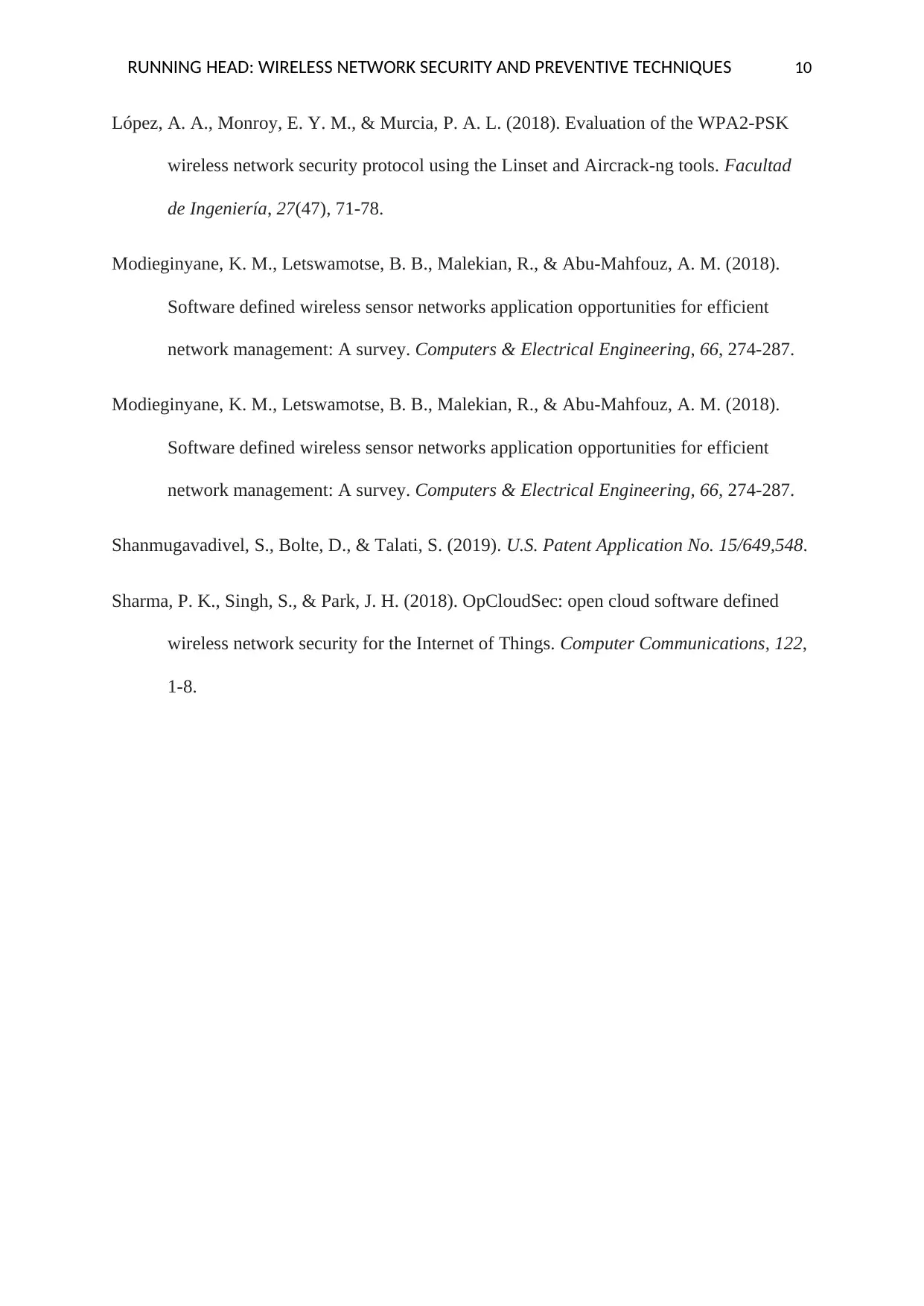
RUNNING HEAD: WIRELESS NETWORK SECURITY AND PREVENTIVE TECHNIQUES 10
López, A. A., Monroy, E. Y. M., & Murcia, P. A. L. (2018). Evaluation of the WPA2-PSK
wireless network security protocol using the Linset and Aircrack-ng tools. Facultad
de Ingeniería, 27(47), 71-78.
Modieginyane, K. M., Letswamotse, B. B., Malekian, R., & Abu-Mahfouz, A. M. (2018).
Software defined wireless sensor networks application opportunities for efficient
network management: A survey. Computers & Electrical Engineering, 66, 274-287.
Modieginyane, K. M., Letswamotse, B. B., Malekian, R., & Abu-Mahfouz, A. M. (2018).
Software defined wireless sensor networks application opportunities for efficient
network management: A survey. Computers & Electrical Engineering, 66, 274-287.
Shanmugavadivel, S., Bolte, D., & Talati, S. (2019). U.S. Patent Application No. 15/649,548.
Sharma, P. K., Singh, S., & Park, J. H. (2018). OpCloudSec: open cloud software defined
wireless network security for the Internet of Things. Computer Communications, 122,
1-8.
López, A. A., Monroy, E. Y. M., & Murcia, P. A. L. (2018). Evaluation of the WPA2-PSK
wireless network security protocol using the Linset and Aircrack-ng tools. Facultad
de Ingeniería, 27(47), 71-78.
Modieginyane, K. M., Letswamotse, B. B., Malekian, R., & Abu-Mahfouz, A. M. (2018).
Software defined wireless sensor networks application opportunities for efficient
network management: A survey. Computers & Electrical Engineering, 66, 274-287.
Modieginyane, K. M., Letswamotse, B. B., Malekian, R., & Abu-Mahfouz, A. M. (2018).
Software defined wireless sensor networks application opportunities for efficient
network management: A survey. Computers & Electrical Engineering, 66, 274-287.
Shanmugavadivel, S., Bolte, D., & Talati, S. (2019). U.S. Patent Application No. 15/649,548.
Sharma, P. K., Singh, S., & Park, J. H. (2018). OpCloudSec: open cloud software defined
wireless network security for the Internet of Things. Computer Communications, 122,
1-8.
1 out of 10
Related Documents
Your All-in-One AI-Powered Toolkit for Academic Success.
+13062052269
info@desklib.com
Available 24*7 on WhatsApp / Email
![[object Object]](/_next/static/media/star-bottom.7253800d.svg)
Unlock your academic potential
Copyright © 2020–2025 A2Z Services. All Rights Reserved. Developed and managed by ZUCOL.




